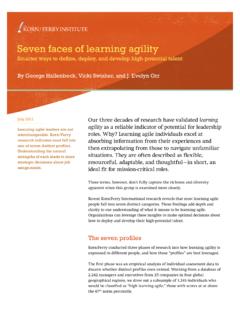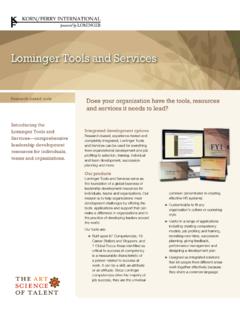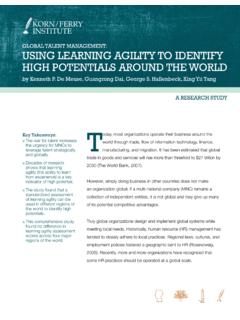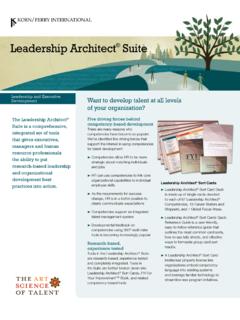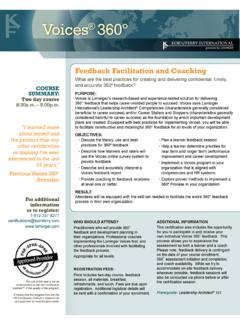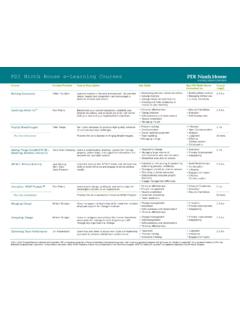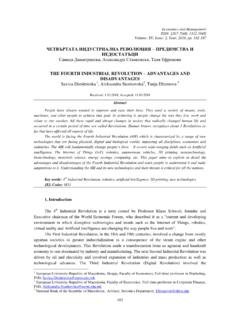Transcription of FUTURE OF WORK THE GLOBAL TALENT CRUNCH
1 THE GLOBAL TALENT CRUNCHA GLOBAL TALENT crisis could cost nations trillions of dollars in unrealized annual revenues, new Korn Ferry study TALENT CRUNCH an imminent skilled labor shortage affecting both developed and developing economies could ultimately shift the GLOBAL balance of economic power by 2030 if left OF WORKWHAT S : The GLOBAL sector perspective:Financial and business , media, and telecommunications (TMT). regional perspective:The Americas. Europe, Middle East, and Africa (EMEA). Asia last this study estimates the impending TALENT CRUNCH by modeling the gap between FUTURE labor supply and demand. We uncover the extent of the TALENT shortfall in 20 major economies at three milestones: 2020, 2025, and 2030. The model focuses on three knowledge-intensive sectors within each market that act as critical drivers of GLOBAL economic growth: financial and business services; technology, media, and telecommunications (TMT); and manufacturing, and also examines the remainder of each economy.
2 Using level of education as a commonly accepted proxy for skills, and taking into account forecast productivity gains, the study uses available data to forecast shortages for highly skilled, mid-skilled, and low-skilled workers to reveal an imminent TALENT major crisis is looming over organizations and economies throughout the world. By 2030, demand for skilled workers will outstrip supply, resulting in a GLOBAL TALENT shortage of more than million people. Signs are already emerging that within two years there won t be enough TALENT to go around. In countries with low unemployment and booming manufacturing production, including the Czech Republic, Poland, Hungary and Slovakia, a labor shortage has already accelerated automation and increased use of robotics not to replace people, but because there aren t enough of them to fill the factories. Left unchecked, the financial impact of this TALENT shortage could reach $ trillion in unrealized annual revenue by 2030, equivalent to the combined GDP of Germany and Japan.
3 The United States alone could miss out on $ trillion in revenue due to labor shortages, or roughly 6% of its entire economy. While leaders are betting heavily on technology for FUTURE growth a 2016 Korn Ferry survey found that 67% of CEOs believe technology will be their chief value generator in the FUTURE of work they cannot discount the value of human capital. Even companies that are using more robotics foresee a growing need for human TALENT with advanced skills; for example, redeploying people from the factory floor, where robots can perform repetitive work, to the research laboratory. The problem, however, is the mismatch between technological advances, including automation, artificial intelligence (AI), and machine learning, and the skills and experience workers need to leverage these advanced tools. Technology cannot deliver the promised productivity gains if there are not enough human workers with the right skills.
4 This has set the scene for a GLOBAL TALENT TALENT CRUNCH , as modeled in this study, refers to the gap between TALENT supply and demand at three critical milestones: 2020, 2025, and 2030. This report seeks to help leaders successfully plan and execute on their strategies, despite the risk, by examining the scale, impact, and timing of the TALENT CRUNCH and what it means for organizations over the long term. For this study, we assessed the TALENT -supply gap in 20 developed and developing economies across the Americas (Brazil, Mexico, the United States), Europe, the Middle East, and Africa (EMEA; France, Germany, the Netherlands, Russia, Saudi Arabia, South Africa, the United Arab Emirates, and the United Kingdom), and Asia Pacific (Australia, China, Hong Kong, India, Indonesia, Japan, Malaysia, Singapore, and Thailand). What we found is that GLOBAL growth, demographic trends, underskilled workforces, and tightening immigration mean that even significant productivity leaps enabled by technological advances will be insufficient to prevent the TALENT granularly, we examined TALENT supply and demand in each of the 20 economies as a whole and within three major knowledge-intensive industries financial and business services (including insurance and real estate), technology, media, and telecommunications (TMT), and manufacturing and at three distinct skill levels, referenced throughout as: 1.
5 Highly skilled workers (Level A): These individuals have completed post-secondary education, such as college or university, or a high-level trade college Mid-skilled workers (Level B): These individuals have attained upper secondary education, such as high school, or a low-level trade college Low-skilled workers (Level C): These individuals have less than upper secondary education. findings forecast the scale and impact of the TALENT crisis at each milestone in terms of skilled employee shortages and what they imply in terms of lost opportunity for value creation. For instance, the United States financial services sector will suffer the most from stunted growth due to lack of TALENT , with $ billion in projected unrealized economic output, equal to about of the country s entire economy. For the all-important technology sector, we found that a labor-skills shortage will reach million workers by 2030, or 59 times the number of employees of Alphabet, Google s parent company.
6 On the positive side, India is projected to have a skilled-labor surplus of around million workers by 2030, the only country in our study expected to have a surplus, owing mainly to its vast supply of working-age citizens and government programs to boost workers , there is time to mitigate the risk. Governments and organizations must make TALENT strategy a key priority and take steps now to educate, train, and upskill their existing workforces. This report will help leaders understand how TALENT shortages are impacting their sectors and the regions where they operate so they can immediately begin to address the TALENT CRUNCH before they fall behind and suffer the economic consequences. Time is running workerstrillion unrealized revenue6 Overview: The GLOBAL perspective. By 2030, we can expect a TALENT deficit of million workers across the economies analyzed greater than the current population of Germany.
7 The shortfall of Level A workers could equal 21% of the highly skilled workforce of the 20 countries in our study. India is the only country analyzed that can expect a TALENT surplus, driven by a burgeoning working-age GLOBAL skills shortage could result in $ trillion in unrealized annual revenue by 2030 equivalent to the combined GDP of Germany and impact of the TALENT CRUNCH is so significant that the continued predominance of sector powerhouses is in question, from London as a GLOBAL financial services center to the United States as a technology leader to China as a key manufacturing a result, organizations may be prompted to relocate their headquarters and operational centers to places where the TALENT supply is more plentiful. Governments will be forced to invest in improving their people s skills to avert corporate flight and to defend their nations income and status.
8 7 Total GLOBAL TALENT deficit by economy Surplus 0 Deficit 0 - 6 millionSignificant deficit 6 million - 12 millionAcute deficit 12 million - 18 millionSurplus 0 Deficit 0 - 6 millionSignificant deficit 6 million - 12 millionAcute deficit 12 million - 18 million20202030 These heat maps show the intensity of labor shortages across the economies analyzed, and demonstrate how shortages will worsen between 2020 and 2030. The acuteness of an economy s deficit is based on its overall shortage of workers, not accounting for the size of its total GLOBAL labor deficit as a percentage of workforce Unrealized output due to labor deficit$ trilionUnrealized outputdue to labor deficit$ trillion Unrealized outputdue to labor deficit$ trillion WorkforceLabor Deficit2020202520303%97%6%94%11%89%9 Financial and business TALENT shortages threaten financial services? 2030: Labor skills shortage of million workers and unrealized output of $ trillion.
9 Financial and business services is one of the world s most important sectors in terms of contribution to GDP and it s the sector most threatened by severe TALENT shortages. Our study forecasts a deficit of million workers by 2030, equivalent to more than 45 times the GLOBAL workforce of HSBC Bank. Markets in our study could miss out on generating $ trillion of revenue by 2030 due to skills shortages in the financial and business services sector. The top five financial centers in our study the United States, China, the United Kingdom, Germany, and France could fail to generate $ billion by 2030, with the United States accounting for half of this (equivalent to of the projected 2030 US economy). European financial centers like the UK and Germany could struggle to retain their GLOBAL positions due to looming skilled- TALENT shortages, with the UK facing a skills shortage equivalent to a fifth of its sector workforce by 2030.
10 Japan, the world s sixth biggest financial center, could fail to generate $ billion in 2030, equivalent to more than 18% of the sector s potential value in 2030. India is the only country expected to have a surplus of highly skilled financial and business services labor by sector 0 Deficit 0 - 600,000 Significant deficit 600,000 - millionAcute deficit million or greater2030 GLOBAL financial and business services TALENT deficit by economyThe acuteness of an economy s deficit is based on its overall shortage of workers, not accounting for the size of its total of workers 10,699,380 5,542,129 2,940,765 Unrealized output$ billionUnrealized output$ billionUnrealized output$ trillionFinancial and business services labor knowledge economy dominated by financial and business services is a key economic driver for both developed and developing markets. In the United States and the United Kingdom, the sector now comprises roughly a third of the economy, and in Germany it represents almost a quarter.
